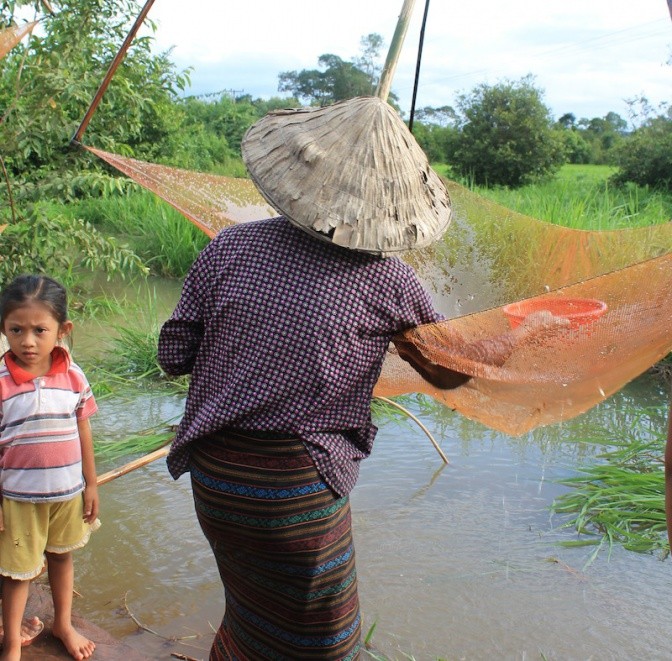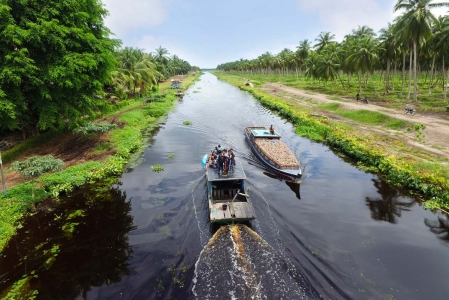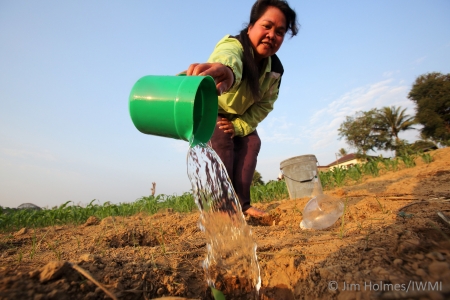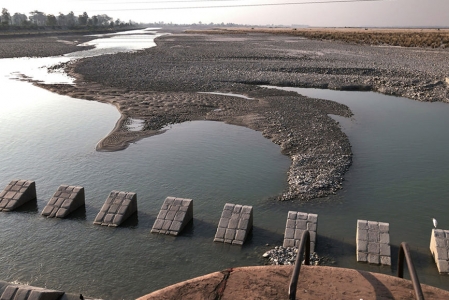In honor of World Wetlands Day, February 2, 2015, we highlight the role of wetlands in the Greater Mekong Subregion. Read more about World Wetlands Day here.
At a meeting in Nay Pyi Taw, Myanmar last week, Environment Ministers of the Greater Mekong Subregion reaffirmed their commitment to “green” economic growth. The challenge they recognized is ensuring not only sustainable growth but also inclusive and shared growth.
 Fishing in Bueng Kiat Ngong wetland, Lao PDR. Photo: Matthew McCartney/IWMI
Fishing in Bueng Kiat Ngong wetland, Lao PDR. Photo: Matthew McCartney/IWMINatural ecosystems (including forests, wetlands and water bodies) and the ecosystem services that they provide, underpin the socioeconomic development of the region. It is estimated that this “natural capital” equates to between 20 and 55% of the total wealth of the countries of the Greater Mekong Subregion (GMS). However, the inter-linkages between the natural environment and economic development are typically undervalued or invisible in traditional indicators of economic growth, such as GDP. As a result, degradation of ecosystems continues apace.
Natural capital in the GMS is under increasing pressure from population growth, the changing consumption patterns of a burgeoning middle class and climate change, as well as rapid and often poorly planned development.
Over the five-year period from 2014 to 2018, more than 30 billion dollars of high priority investment has been planned for the GMS region. Much of this investment will be for infrastructure, particularly roads and railways. Compared to the $16.7 billion invested during the first 20 years of the GMS Economic Cooperation Program (1992 -2012) this represents double the investment in a quarter of the time. Whilst creating new economic opportunities this level of investment also carries environmental and social costs that have yet to be fully understood. The impact on the natural capital of the region is potentially huge.
Natural capital contributes significantly to GMS economy
Natural capital is a particularly crucial component of rural livelihoods. In the GMS more than 60 million people rely on natural capital for their daily energy, food, water and income needs. Fisheries, supported by the Mekong and the other mighty rivers of the region, such as the Ayeyarwady and Salween in Myanmar and the Red River in Vietnam, provide between 50 and 80% of the animal protein consumed in the GMS.
Agriculture would not be possible in the absence of ecosystem services, such as natural soil fertility and pollination. Degradation of ecosystems, land, water and soil, undermines agricultural productivity and threatens the wellbeing of poor farmers, particularly women. Currently, it is estimated that 10-40% of arable land in the GMS is degraded with the result that farming is more costly and the benefits to poor farmers are significantly less than they could be.
Wetlands represent a particularly important component of natural capital in the GMS and are vital to the livelihoods of many millions of people. About 25% of the Lower Mekong Basin is classed as wetland and many rural livelihoods are essentially wetland livelihoods: based around the cultivation of rice – a wetland crop – and the harvesting of a range of aquatic resources, not just fish, but also snails, frogs, reeds and other water plants.
Wetlands are essential to the food security, nutrition and culture of rural communities. With large seasonal changes in water levels, people must adapt to both dry periods and periods of flooding. In such circumstances, diversity is essential, allowing people to alter their livelihood strategy depending on circumstances; reducing risks and maximizing the benefits that the environment offers.
Despite their vital importance there has been widespread loss of wetlands in the GMS. Less than 2% of the original natural wetlands in the Mekong Delta remain and the overall loss of wetlands is estimated to be 96% in Thailand, 45% in Cambodia and 30% in Lao PDR. In the Ayeyarwady Delta in Myanmar, mangroves vital for fisheries are rapidly being destroyed. The loss and degradation of wetlands is a significant threat not just to wetland dependent biodiversity but also the livelihoods of the people that depend on them.
Not a trivial task: filling the information gaps
One of the problems facing the wise use of these wetlands is a lack of information. Even simple data describing where they are and how they change over time is difficult to obtain, and what little does exist is typically out of date, inconsistent and unreliable. This is not surprising and is unfortunately not a feature that is limited to this region of the world, as mapping wetlands is a far from trivial task. The difficulty with wetland mapping is that wetlands are neither always wet, nor always dry, and that a snapshot of what is wetland at a particular point in time holds little value.
A new global map of wetlands has recently been produced, in an attempt to fill this gap. The map was generated from satellite images obtained over a twelve-year period. It shows patterns of inundation in more detail than previously available and over a longer time period, and can be used to distinguish between permanent and temporary wetlands. Importantly, it allows scientists, site managers and others to visualize the dynamics of these ecosystems.
For the Tonle Sap in Cambodia, the largest water-body in the GMS, the map shows the large changes which take place between the wet and dry seasons, as well as differences in patterns of flooding between years. Such information is vital if the wetland is to be properly managed. It is this large variation that ensures the Tonle Sap supports one of the most important freshwater fisheries on the planet.
Reality and Rhetoric
Ministers of the Greater Mekong Subregion are increasingly aware of the importance of wetlands and natural capital. But do they have the full ability to influence how wetlands are managed and used?
Real change will only come when finance ministers and those in charge of economic planning are also aware; investment strategies need to reflect the true value of natural capital. It should also be remembered that the conservation of wetlands lies as much in the hands of local communities and civil society as with the policy makers whose policies and projects impact upon them.















Comments
Hi there,
Thanks for your valuable articles :)
Actually I was looking for this types of information. As a agriculturist I know the importance of wet and dry land condition. For successful paddy cultivation it also play a vital role.
Again thanks for your great information.
Regards,
Review
Indeed the contribution of natural capital to agriculture is now being realized. Degradation of natural capital puts agricultural production at risk. Ultimately the ability of countries to grow sufficient safe and nutritious food is undermined if natural capital is degraded. In the GMS a drop in agricultural productivity would have major implications for human well-being, particularly for women who are often responsible for food production, and overall household food security and nutrition.
Thank you, Matthew McCartney for your post. Wetlands play key role in economic growth for any country. In addition, it Improves water quality, reduce flood damage, soil erosion and takes a part of groundwater recharge / discharge cycle. It provides habitat. It is also a source of recreation and tourism. Regarding climate change, it performs two important functions having mitigation effects through their ability to sink carbon along with adaptation effects through their ability to store and regulate water. Therefore, losing wetlands it could be harmful to its dependent biodiversity and Human beings.
Again thanks for your valuable information
Samad, many thanks for your comment. The important contribution that wetlands make to economic development and peoples well being is now increasingly appreciated. However, I think it is important to remember that not all wetlands perform all the services that you mention. Their actual role is very dependent on the wetland type and location within the landscape as well as the interactions with people. Consequently for planning and management it is very important to have a good understanding of wetland functions and how they vary both in space and over time.